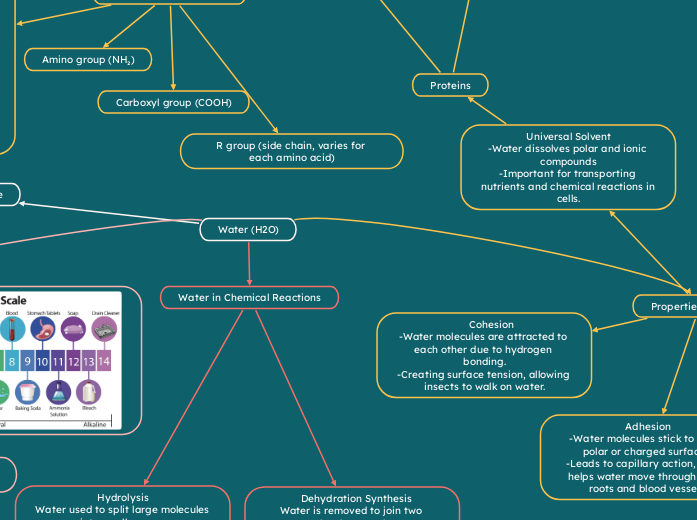Water (H2O)
Water's Molecular Structure
- 2 hydrogens 1 oxygen
- Shared by covalent bonds
- V shaped
- Oxygen atoms, slight negative charge, meaning they are greedy for electrons.
- Hydrogen atoms,slight positive charge, meaning they want to give away their electrons.
Due to this polarity, all water molecules are attracted to one another and once they're all stuck together, those are called hydrogen bonds. The positive pole around one hydrogen atom will bond to the negative pole around the oxygen atoms of another water molecule.
Properties of Water
Cohesion -Water molecules are attracted to each other due to hydrogen bonding.
-Creating surface tension, allowing insects to walk on water.
Adhesion
-Water molecules stick to other polar or charged surfaces.
-Leads to capillary action, which helps water move through plant roots and blood vessels.
High Heat of Vaporization
-Takes lots of energy to convert water from liquid to gas.
-Sweating and transpiration help organisms cool down as water evaporates.
Universal Solvent
-Water dissolves polar and ionic compounds
-Important for transporting nutrients and chemical reactions in cells.
Proteins
Functions
Enzymatic Activity
- Proteins act as enzymes to speed up chemical reactions.
- Ex. Amylase breaks down starch into sugars.
Structural Support
Proteins like collagen and keratin provide strength and structure
Transport
Hemoglobin carries oxygen in red blood cells
Signaling
Hormones like insulin act as chemical messengers
Immune Defense
Antibodies are proteins that help protect against pathogens
Structure
Amino Acids (Building Blocks)
20 types of amino acids
Amino group (NH₂)
Carboxyl group (COOH)
R group (side chain, varies for each amino acid)
Peptide Bond
Levels of Protein Structure
Primary Structure
Sequence of amino acids (polypeptide chain)
Quaternary
Multiple polypeptide chains interacting
Tertiary Structure
3D folding due to interactions between R groups
Secondary Structure
Alpha helices or beta sheets formed by hydrogen bonding
Hydrophobicity
- Non-polar and repel water
- Hydrophobic molecules form separate layers rather than dissolving
Lipids
Types
Triglycerides (Fats & Oils)
- 1 glycerol + 3 fatty acids
- Long-term energy storage, insulation, protection
Saturated fats
No double bonds (solid at room temp)
Unsaturated fats
One or more double bonds (liquid at room temp
Phospholipids
- 1 glycerol + 2 fatty acids + phosphate group
- Form cell membranes (phospholipid bilayer)
- Hydrophilic head & Hydrophobic tail → Forms selective barrier
Steroids
- Four fused carbon rings
- Hormone signaling, cell membrane stability
Waxes
- Waterproofing
Functions
- Energy storage
- Cell membrane structure
- Insulation & Protection
- Hormone production
- Waterproofing
pH & Water (Acids, Bases, and Neutrality)
pH Scale (0-14)
Neutral (pH = 7): Pure water has equal amounts of H⁺ and OH⁻ ions.
Bases (pH > 7): High concentration of OH⁻ ions
Acids (pH < 7): High concentration of H⁺ ions
Water in Chemical Reactions
Hydrolysis
Water used to split large molecules into smaller ones.
Ex. Sucrose + H₂O → Glucose + Fructose
Nucleic Acids
Nucleic Acids
DNA (Deoxyribonucleic Acid)
- Stores genetic information
- Double-stranded (double helix)
- Bases: A-T, G-C
RNA (Ribonucleic Acid)
- Helps in protein synthesis
- Single-stranded
- Bases: A-U, G-C
Types:
mRNA→ Carries genetic code from DNA to ribosomes
rRNA → Forms part of ribosomes
tRNA → Brings amino acids to ribosomes
ATP (Adenosine Triphosphate)
- Energy carrier in cells
- High-energy phosphate bonds
Nucleotides
- Sugar (Deoxyribose in DNA, Ribose in RNA)
- Phosphate group
- Nitrogenous base (A, T/U, G, C)
Function
w
RNA: Helps build proteins
ATP: Provides energy for cellular activities
Dehydration Synthesis Water is removed to join two molecules together.
Ex.
Glucose + Glucose → Maltose + H₂O
Carboydrates
Types
Monosaccharides (Simple Sugars)
- Ex. Glucose, Fructose, Galactose
- Function: Quick energy source
Disaccharides (Two Monosaccharides Linked)
- Ex. Sucrose, Lactose, Maltose
- Formed by dehydration synthesis
- Broken down by hydrolysis
Polysaccharides (Complex Carbohydrates)
Storage Polysaccharides
- Starch (plants) → Stores glucose for energy
- Glycogen (animals) → Stored in liver & muscles
Structural Polysaccharides
- Cellulose (plant cell walls, indigestible to humans)
- Chitin (fungal cell walls, exoskeletons)
Functions
- Primary Energy Source
- Energy Storage
- Structural Support
